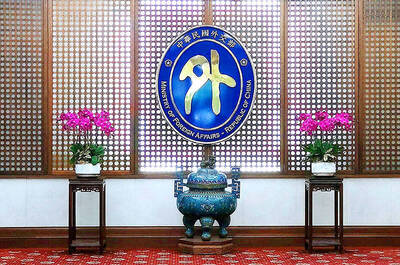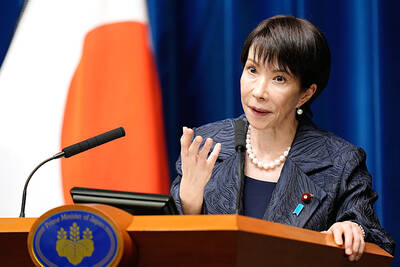Since the 921 Earthquake in 1999, scientists have thrown everything into identifying predictors of the devastating phenomenon, looking beneath the ground and even from space in a bid to improve understanding of the mechanisms responsible.
Standing beside a monitor detecting crust deformations at National Dong Hwa University in Hualien last year, National Central University geophysicist Yen Horng-yuan (
According to Yen, studies of past earthquakes suggest there is an association between the phenomenon of advance crust deformation and the onset of earthquakes.

PHOTO: CHIU YU-TZU, TAIPEI TIMES
"By carrying out continuous monitoring, we can analyze an abundant amount of data to find out where the crust begins to change before the occurrence of an earthquake. This data might be useful for research on predicting quakes," Yen said.
By the end of 2006, another 30 stations will be set up around the country to complete the GPS network, he said.
Taiwan sits atop the junction of the Philippine plate and the much larger Eurasian plate. The former is slowly being forced beneath the latter under the northern stretches of the country. The process, referred to by seismologists as subduction, is also being monitored by local geophysicists.
Since August 1998, Lee Jian-cheng (李建成), an associate research fellow at Academia Sinica's Institute of Earth Sciences, has measured crust change with creepmeters set up at Tapo Elementary School in Taitung County, which lies on the active Chihshang Fault (池上斷層).
Creepmeters measure the displacement between areas located on opposite sides of a fault.
Lee said that research suggests the Philippines and Eurasia plates are converging at a speed of 8cm per year. However, Lee's continuous monitoring of the plate suture zone in the Huatung Valley connecting Hualien and Taitung suggests that the fault has contracted between 15cm and 20cm annually over the past five years.
"We are seeing significant fault activity here. So we will continue to study how the fault interacts with others nearby in the valley," he said.
The 200km-long Chihshang Fault is only one of seven active faults to have been discovered in the Huatung Valley. In 1951, two earthquakes resulting from dramatic fault activity here ruptured the surface and changed its topography all the way from Hualien to Taitung. At some locations, the land was raised by 75cm.
To better understand these faults' behavior, National Taiwan University geosciences professor Chen Wen-shan (
"Faults in this valley are regarded by scientists as the most active in Taiwan. By analyzing layers in the trenches we can study the old earthquakes that they caused, and we might develop ideas on predicting future activity," Chen said.
Prior to the 921 Earthquake, which claimed more than 2,400 lives, most Taiwanese had grown less concerned about the occurrence of a devastating temblor.
But a number of earthquakes of similar destructive force did occur earlier last century. The 7-magnitude Meishan Earthquake in 1906 killed more than 1,250 people in the country's southwest. A 7.4-magnitude earthquake in 1935 centered in the Hsinchu-Miaoli area killed over 3,200 people; a 6.5-magnitude aftershock then killed another 2,700.
In the wake of the 921 Earthquake, which also injured more than 8,700 people and left 100,000 people homeless, the National Science Council boosted funding for earthquake-related research. Seismologists, geologists and physicists have since teamed up on innovative projects in a bid to discover signs of when the next one will strike.
Scientists have for years speculated that electromagnetic phenomena might be connected to seismic activity. Now, local physicists have decided to look to space to gather more clues.
Liu Jann-yenq (
After analyzing data of more than 300 earthquakes in Taiwan between 1994 and last year with magnitudes greater than 5, Liu found that for 70 percent of the quakes, ionospheric electron density fell sharply to around 65 percent of the normal level some time in the five days before the temblor.
Liu said that if the magnitude was 6 or higher, around 80 percent of sampled quakes had the same effect.
"We're only trying to find precursors to earthquakes. It doesn't mean we've already established a theory for a mechanism of earthquake prediction," Liu said.
However, he said, the drop in ionospheric electron density did not correlate entirely with the occurrence of earthquakes because other causes of change in electron density are known to exist.
Chen Chau-huei (陳朝輝), a seismologist at National Chung Cheng University, told the Taipei Times that local resources for seismology research remain limited. He said there were only 30 professionals delving into earthquakes.
"Actually, Taiwan can be a leading focus of seismological research because the environment in which we live is actually a natural museum for earthquakes," Chen said.

The Ministry of Foreign Affairs (MOFA) yesterday voiced dissatisfaction with the Comprehensive and Progressive Agreement for Trans- Pacific Partnership (CPTPP), whose latest meeting, concluded earlier the same day, appeared not to address the country’s application. In a statement, MOFA said the CPTPP commission had "once again failed to fairly process Taiwan’s application," attributing the inaction to the bloc’s "succumbing to political pressure," without elaborating. Taiwan submitted its CPTPP application under the name "Separate Customs Territory of Taiwan, Penghu, Kinmen and Matsu" on Sept. 22, 2021 -- less than a week after China

THE GOOD WORD: More than 100 colleges on both sides of the Pacific will work together to bring students to Taiwan so they can learn Mandarin where it is spoken A total of 102 universities from Taiwan and the US are collaborating in a push to promote Taiwan as the first-choice place to learn Mandarin, with seven Mandarin learning centers stood up in the US to train and support teachers, the Foundation for International Cooperation in Higher Education of Taiwan (FICHET) said. At the annual convention of the American Council on the Teaching of Foreign Languages held over the weekend in New Orleans, Louisiana, a Taiwan Pavilion was jointly run by 17 representative teams from the FICHET, the Overseas Community Affairs Council, the Steering Committee for the Test of Proficiency-Huayu, the

A home-style restaurant opened by a Taiwanese woman in Quezon City in Metro Manila has been featured in the first-ever Michelin Guide honoring exceptional restaurants in the Philippines. The restaurant, Fong Wei Wu (豐味屋), was one of 74 eateries to receive a “Michelin Selected” honor in the guide, while one restaurant received two Michelin stars, eight received one star and 25 were awarded a “Bib Gourmand.” The guide, which was limited to restaurants in Metro Manila and Cebu, was published on Oct. 30. In an interview, Feng Wei Wu’s owner and chef, Linda, said that as a restaurateur in her 60s, receiving an

MORE RETALIATION: China would adopt a long-term pressure strategy to prevent other countries or future prime ministers following in Sanae Takaichi’s steps, an academic said Taiwan should maintain communications with Japan, as Japanese Prime Minister Sanae Takaichi is to lead a revision of security documents, Taiwanese academics said yesterday. Tensions have risen between Japan and China over remarks by Takaichi earlier this month that the use of force against Taiwan would constitute a “survival-threatening situation” for Japan. Prospect Foundation president Lai I-chung (賴怡忠) yesterday said Takaichi’s stance regarding Taiwan is the same as past Japanese prime ministers, but her position is clearer than that of her predecessors Fumio Kishida and Shigeru Ishiba. Although Japan views a “Taiwan contingency” as a “survival-threatening situation,” which would allow its military to